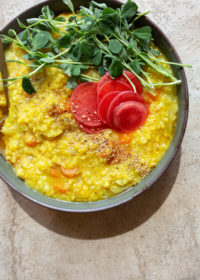Ayurveda: Rasa – The Six Tastes of Ayurveda | Sweet
 With all the holidays (and birthdays!) going on during winter, we tend to gravitate towards all things sweet, from baked goods to hot drinks – sugar is abundant! This post from my favorite guest blogger, Adena Harford of Adena Rose Ayurveda, couldn’t have come at a more appropriate time. She explores the realm of sweet, known as Madhura in the six tastes of Ayurveda, and what it means in the context of your nutrition and overall health. Make sure to check out her last post, an alternative introduction to Ayurveda to get you thinking about this holistic health model from a whole new perspective.
With all the holidays (and birthdays!) going on during winter, we tend to gravitate towards all things sweet, from baked goods to hot drinks – sugar is abundant! This post from my favorite guest blogger, Adena Harford of Adena Rose Ayurveda, couldn’t have come at a more appropriate time. She explores the realm of sweet, known as Madhura in the six tastes of Ayurveda, and what it means in the context of your nutrition and overall health. Make sure to check out her last post, an alternative introduction to Ayurveda to get you thinking about this holistic health model from a whole new perspective.
Talking Rasa: Exploring the Six Tastes of Ayurveda
“Let food be thy medicine, and medicine be thy food,” says Hippocrates. I think most of us are familiar with this saying, and have our own ways of understanding it. Perhaps to you it means to eat more fruits and veggies. Perhaps to you it means incorporating more prana-filled foods into your diet. Perhaps it means laying off the gluten or dairy for a while so you can get allergies under control. In this series for the Vidya blog, I will explore Ayurvedic principles of food as medicine through the understanding of rasa, or taste. Rather than wrapping our intellect around nutritional facts and figures, we can use our tongue to learn how the things we eat are going to affect our tissues, as well as our state of mind.
Everything we take in through our senses eventually affects our consciousness. Though this may sound like an esoteric idea, it’s easy to feel in your own being. All of the sense organs (eyes, ears, nose, skin, and tongue) accept information from our external environment. Often in my classes I use an example from the Lord of the Rings trilogy, noting the differences between the Elves and the Dwarves. The Elves are ethereal beings, with expanded consciousnesses, who are actually on the verge of moving from this lower, more tangible world, to the more subtle realms. Their diet is clean, green, fresh and vegetarian. They are also physically light, thin and tall. Elves would be considered sattvic, which is a term yoga and ayurveda use to describe a balanced consciousness. The dwarves are physically heavier, denser, more of the earth, and their diet reflects this – cheese, meat, bread and beer – and so does their way of being. They are most attached to physical existence and pleasures, and though they are hard workers, they are also warriors, focusing on winning battles fought on the physical level, as opposed to the ‘warriors of light’ the Elves seem to be. This said, the dwarves are more rajasic and tamasic in nature.
In this same example, the humans fall somewhere in between. For us to stay balanced physically, mentally and emotionally, we need to be balanced in the qualities we take in. Each of the tastes is a signifier to us how the substance will affect our bodies, and the maha gunas (sattva, rajas and tamas) which govern our state of mind.
Ayurveda explains that there are six tastes: Sweet, Sour, Salty, Pungent, Bitter and Astringent. Some of these may seem obvious, and others enigmatic. Each of the tastes is also comprised of the five elements, two which are the most dominant. This means that the tastes affect the doshas, Vata, Pitta and Kapha. Let’s explore the most important of the tastes first, and one which has been most manipulated in our diets: Sweet.

Madhura : Sweet
The Ayurvedic classics mention that the sweet taste should dominate our diet. The sweet taste is considered the most sattvic – in appropriate amounts cultivating compassion, peacefulness, and love. Our SAD (standard American diet) also emphasizes the sweet taste, but highly processed and refined sugars are too subtle, affecting our Vata dosha negatively, and containing too much rajas. As sattva is the energy that brings us stillness and peace, rajas is the energy of transformation, passion and disruption. Natural sweetness brings us sustaining, long lasting energy, while these processed sweets bring us quick energy in short bursts, inevitably leaving us lacking and craving more. Our tongues, and our brains, are becoming wired to crave these intense sweets, and we have a harder time being satisfied by a natural sweet taste. Water in inherently sweet, and if our rasa, our ability to sense taste is influenced by sattva, we will crave correct tastes, and reject false or unbalancing foods. It is not bad to desire sweets – the sweet tastes is what builds our tissues, keeps us strong, gives us sustained energy. Sweetness gives us the ability to feel and give love and satisfaction in our lives. Sugars are a necessity to feed our brain and nervous system.
Sweet taste is predominant in the water and earth elements. It is heavy, stabilizing, moist, nourishing, and the after-effect on digestion is overall cooling and calming. In Ayurvedic medicine, an emphasis on the sweet taste in diet is recommended for those who are weak or emaciated, the elderly, and those with Vata and Pitta imbalances – because water and earth elements can balance both Vata and Pitta. Sweet taste will aggravate Kapha dosha, because Kapha is also a combination of the water and earth elements, so the qualities of sweet will increase Kapha qualities in body and mind. An over-indulgence in sweet – even the good sweets – can manifest as sluggishness and lethargy, heaviness and weight gain, an excess of mucus, slow digestion. A proper amount of sweet in one’s diet brings love, satisfaction, calm and steady energy throughout the day, as well as helping you sustain a healthy weight.
Long term, tastes bring their effects to the tissues, but short term – even to each meal or a day – tastes will affect digestion, or agni. Sweet is cooling to the digestive fire, or agni, so it is best to accompany it with some digestive spices (like adding turmeric to warm milk) or ingesting it with mindfulness to dinacharya – an example bring to eat your largest meal at lunch time. As an Ayurvedic Practitioner, I recommend sweet foods to those feeling ungrounded, scattered, or anxious, or who need nourishment in their lymphatic tissue (think breast-feeding mothers), and those who are Vata aggravated, or have certain high-Pitta signs. I would use sweet herbs and spices such as fennel, cinnamon, cardamom, rose, nutmeg or clove and to improve, cool and calm digestive troubles. Special Ayurvedic herbs include Shatavari or Guduchi.
So where can you find healthy sweet taste? Whole grains, milk, and sweet fruits are considered to be the most sattvic foods, and they also are predominantly sweet. Milk is so revered, because it is said to be a gift, given freely from the mother. It is recommended to be warmed, and lightly spiced for best digestion. A bit of warm milk before bed, with nutmeg, turmeric and honey, can help with insomnia. The heavy quality of sweet helps to calm us and lull us to sleep. Whole grains like quinoa, wheat berries, farro, rice, brown rice, barley and oats, even millet, buckwheat and rye, are sweet, and these whole grains sustain our energy and blood sugar levels. Sweet fruits like ripe berries, apricots, coconut, melons, dates, mangoes and papaya are excellent sweet fruits.
Sometimes this is not always as straightforward – for example most bananas have a sweet taste in the mouth, which is rasa, but they are considered to have a sour effect on digestion. A ripe banana, picked freshly off the tree (something I rarely get living here in the north east) may have more of a sweet post-digestive effect. Plain yogurt is not a far step from milk, but it is also considered to have a sour effect – though this is more obvious, as plain, homemade yogurt actually tastes sour.
It’s always a personal exploration, there are so many levels, and so many subtleties to these ‘rules.’ As my teacher, Dr. Claudia Welch always says, this stuff is just a way to describe reality, it’s not reality itself. We can only learn what works best for us through our own senses – the key is heeding what we ‘hear.’ Curious to learn more about the other tastes? Read about Sour, Salty, Pungent, Bitter and Astringent.
—————-
Adena Rose Harford is a NAMA Certified Ayurvedic Practitioner and AyurYoga Specialist offering Ayurvedic Lifestyle Consultations, meal planning and cooking lessons, guided cleansing, Ayurvedic bodywork, and yoga instruction in Vermont. Her 7-day ayurvedic cleanse is available online. If you’re interested in learning more about Ayurveda, follow Adena Rose Ayurveda on Facebook for Ayurvedic tips, recipes and remedies.
 [wpmenucart]
[wpmenucart]
 Living Ayurveda: Meal Planning Tips
Living Ayurveda: Meal Planning Tips  Recipes: My Favorite Kitchari Recipe + Ume Pickled Radishes
Recipes: My Favorite Kitchari Recipe + Ume Pickled Radishes  Interview: A Behind-the-Scenes Look at the Making of A Book
Interview: A Behind-the-Scenes Look at the Making of A Book 
Thank you, Claire! Can’t wait to continue this series.
[…] you catch Sweet and Sour? No, it’s not a new Asian soup-virus, I’m referring to my previous two guest […]
Thank you for sharing this! Much love from Vancouver